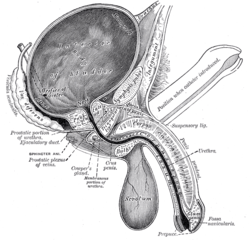Urachus
| Urachus | |
|---|---|
 Vertical section of bladder, penis, and urethra. Urachus is seen at top | |
 Urachus is #1 | |
| Identifiers | |
| MeSH | A16.254.835 |
The urachus is a fibrous remnant of the allantois, a canal that drains the urinary bladder of the fetus that joins and runs within the umbilical cord.[1] The fibrous remnant lies in the space of Retzius, between the transversalis fascia anteriorly and the peritoneum posteriorly.
Development
The part of the urogenital sinus related to the bladder and urethra absorbs the ends of the Wolffian ducts and the associated ends of the renal diverticula. This gives rise to the trigone of the bladder and part of the prostatic urethra.
The remainder of this part of the urogenital sinus forms the body of the bladder and part of the prostatic urethra. The apex of the bladder stretches and is connected to the umbilicus as a narrow canal. This canal is initially open, but later closes as the urachus goes on to definitively form the median umbilical ligament.
Clinical significance
Failure of the inside of the urachus to be filled in leaves the urachus open. The telltale sign is leakage of urine through the umbilicus. This is often managed surgically. There are four anatomical causes:
- Urachal cyst: there is no connection between the bladder and the umbilicus
- Urachal fistula: there is free communication between the bladder and umbilicus
- Urachal diverticulum [Vesicourachal diverticulum]: the bladder exhibits outpouching[2]
- Urachal sinus: the pouch opens toward the umbilicus[3]
The urachus is also subject to neoplasia. Urachal adenocarcinoma is histologically similar to adenocarcinoma of the bowel.
One urachal mass has been reported that was found to be a manifestation of IgG4-related disease.[4]
Additional images
- Inguinal fossae
 CT scan (sagittal reconstruction) showing an urachus rest as an incidental finding in a 44-year-old man, the trajectory moves forward and upward from the bladder to the umbilicus in the midline.
CT scan (sagittal reconstruction) showing an urachus rest as an incidental finding in a 44-year-old man, the trajectory moves forward and upward from the bladder to the umbilicus in the midline. Ultrasound of fetus showing urachus duct from bladder to the umbilicus.
Ultrasound of fetus showing urachus duct from bladder to the umbilicus. Ultrasound of fetus showing urachus duct from bladder to the umbilicus.
Ultrasound of fetus showing urachus duct from bladder to the umbilicus. Ultrasound of fetus showing urachus duct from bladder to the umbilicus.
Ultrasound of fetus showing urachus duct from bladder to the umbilicus. Ultrasound of fetus showing urachus duct from bladder to the umbilicus.
Ultrasound of fetus showing urachus duct from bladder to the umbilicus. Ultrasound of fetus showing urachus duct from bladder to the umbilicus.
Ultrasound of fetus showing urachus duct from bladder to the umbilicus.
References
This article incorporates text in the public domain from the 20th edition of Gray's Anatomy (1918)
- ↑ Larsen, "Human Embryology," 3rd ed., pg. 258
- ↑ Le, Tao; Bhushan, Vikas; Vasan, Neil (2010). First Aid for the USMLE Step 1: 2010 (20th Anniversary ed.). USA: The McGraw-Hill Companies, Inc. p. 122. ISBN 978-0-07-163340-6.
- ↑ Guray, Sogut, et al. (2000) Urachal Cyst. Eastern Journal of Medicine 5(2):76-78.
- ↑ Travis W. Dum; Da Zhang; Eugene K. Lee (2015). "IgG4-Related Disease in a Urachal Tumor". Case Reports in Urology. pp. 1–3. doi:10.1155/2014/275850. PMC 4151357
 . PMID 25202466. 275850.
. PMID 25202466. 275850.
External links
- Swiss embryology (from UL, UB, and UF) turinary/patholurinary07
- Persistent urachus at moorabbinvet.com.au
- Repair at pennhealth.com
- Vesico-urachal Diverticulum Radiology (CT Images)
